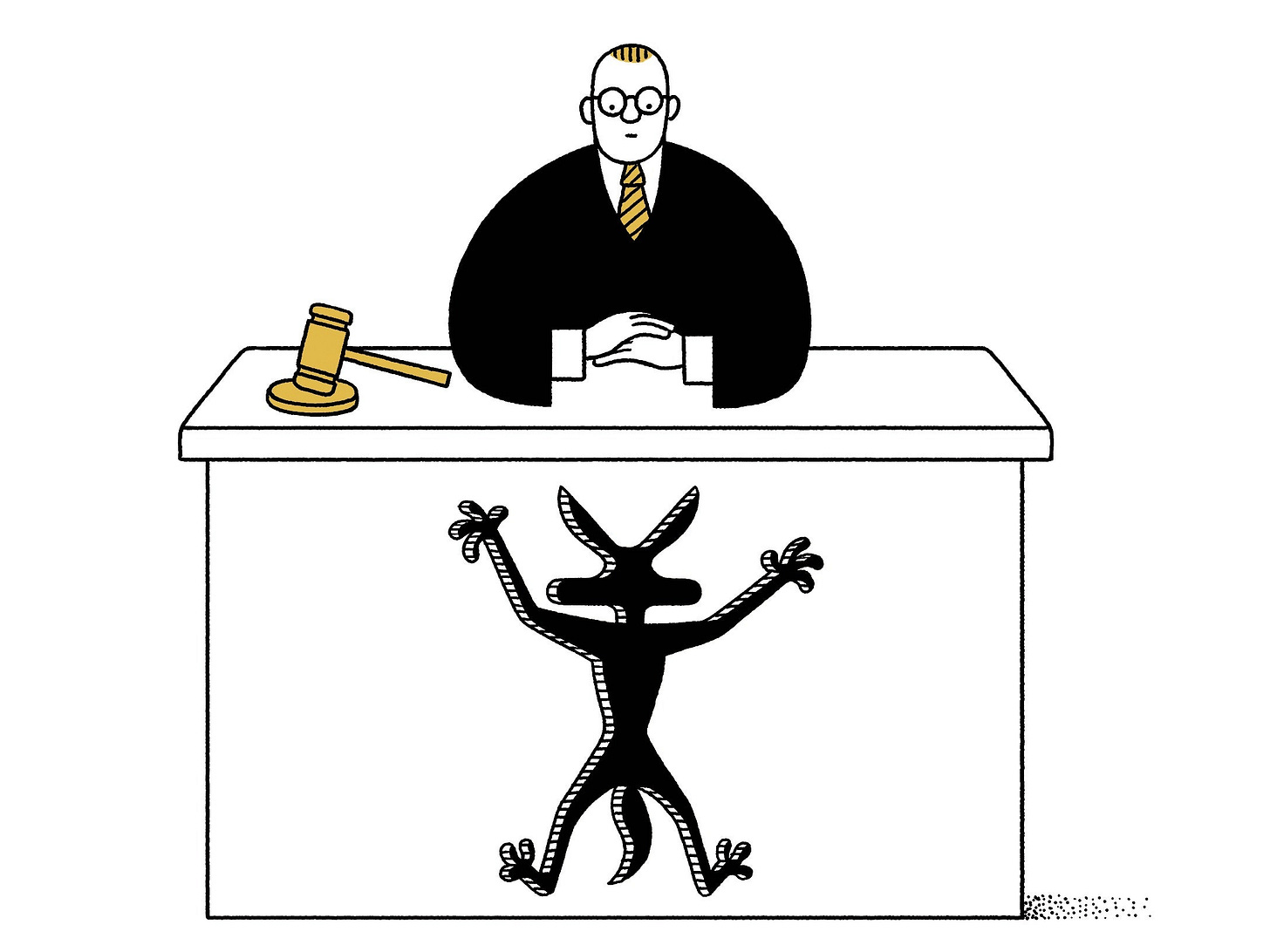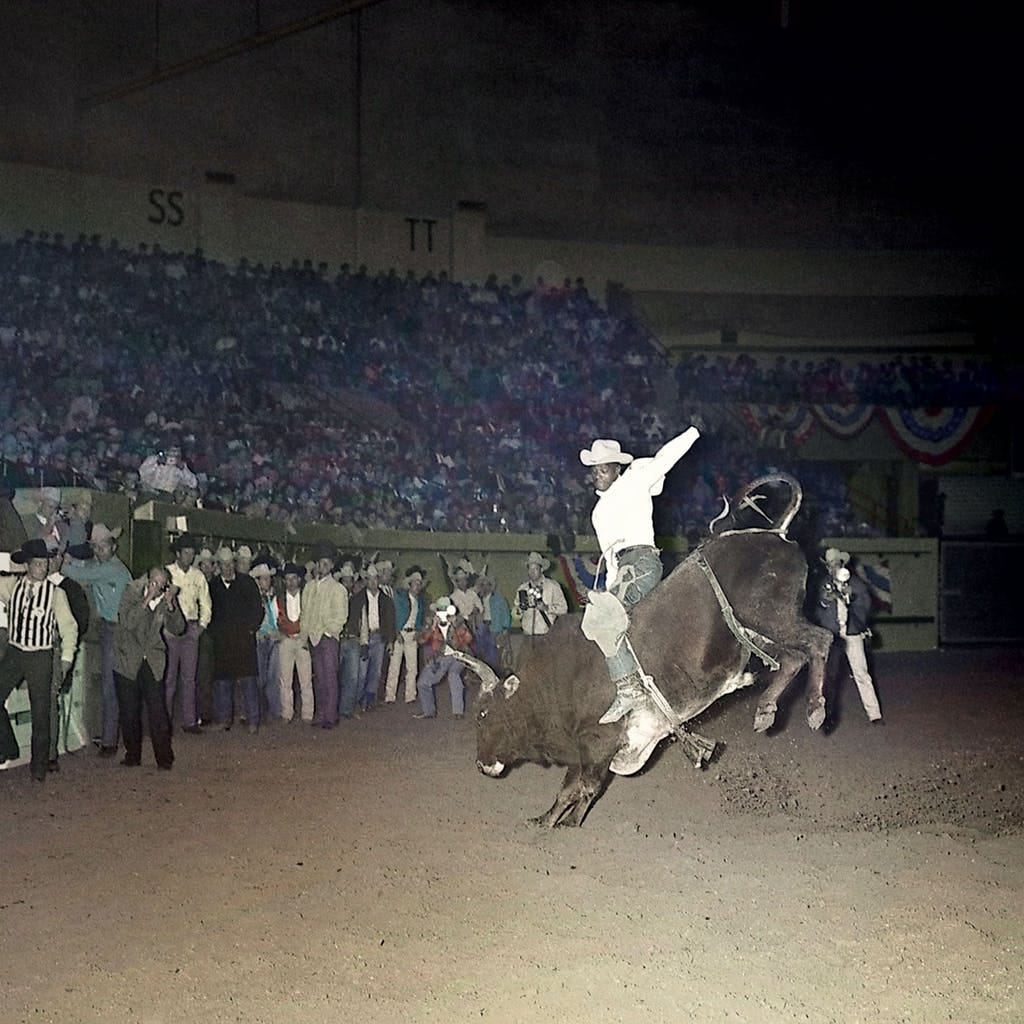An unfinalizable index to the open-ended weird
Hola.
Hope everyone’s hanging steady out there in the world. The weather is starting to change into something a little nicer and I can’t imagine any of us will really be able to psychologically withstand another few months of no bars and no concerts and no sports. It’s taxing, man. Thank god for the internet. I’m going to keep this brief because I went a bit long on some of the actual content below.
If you dig what you’re reading and want to receive these monthly-ish downloads straight to your old inbox, click on the link below.
READS

— I chuckled my way through Ian Frazier’s 1990 New Yorker piece that follows a hypothetical lawsuit of Wile E. Coyote against the Acme Corporation. It’s a good old time, stretching out the descriptions of the various degrees of mayhem that befall him as he hunts the rascally Roadrunner.
— Very into this Real Life piece on UFO culture and how the paranoia surrounding them has evolved into something quite different over the years. This is where the title for this week’s newsletter comes from. “People have been looking at wondrous, seemingly inexplicable things in the sky forever, and investigating the possibility of extraterrestrial life has only raised more questions about how we live our lives on Earth … (They) became a shorthand for the feeling that daily life isn’t all that it seems; that there are machinations at play that powerful people are eager to conceal,” Stephanie Monohan writes. “If we trace the history of ‘unidentified flying objects’ — or rather, the belief in them as alien spacecrafts attempting some sort of contact with human life — a story of a deteriorating American identity and fatalism under capitalism emerges.”
— Fiona Apple’s fifth record, Fetch the Bolt Cutters, came out in the middle of April as the quarantine mindset was really starting to settle over the country. It’s transcendent, angry, prescient, warm, revelatory, and winning. There’s no lack of glowing criticism about it, but I really enjoyed this Jessica Hopper newsletter that’s her in conversation with Jenn Pelly, Hanif Abdurraqib, and Laia Garcia-Furtado. A great Hopper passage from their conversation: “It’s a record that catches folks who are in the long process of reckoning(s), making it a respite as much as it is a vicariously thrilling exhibition of her daring. Which is one of Fiona’s special talents, the way that she flits from raw human to superheroic. And she allows listeners into that, it is really generous and companionable. To have an album that is with you in the abyss of feeling and then offers up fuck yes triumph.” Do yourself a favor and listen to FTBC. Maybe invest in a box of tissues.

— This Texas Monthly article on Myrtis Dightman, the Jackie Robinson of Rodeo, is a damn incredible read. “A lot of folks thought rodeo was a white man’s game, but those bulls don’t care if you’re white or black. You could be green, for all it matters. They just don’t want you on their backs,” Dightman told TM’s Christian Wallace in 2018. I don’t really care about rodeo but stories like this are just so incredible. He was one of the top riders in the ‘60s and would mentor the first black man to win the crown a decade later. “I’ve had a good life,” Dightman said. “I was a cowboy.”
— Paolo Ugetti’s Ringer piece on American basketball players trying to navigate the COVID-19 pandemic while living and playing abroad was a good read.
— Yoooo. Apparently figuring out the age of whale sharks is a thing that couldn’t be done until really recently. Apparently scientists have figured out that they have grow rings with years of age LIKE TREES.

— Really loved this Ethan Warren essay for Bright Wall Dark Room on Hard Eight, particularly the musings on spontaneous friction and the matchbook in John C. Reilly’s pocket that help to capture so much of what Paul Thomas Anderson is trying to say with his desert-set noir: “Anyone carrying a matchbook must be aware that they harbor something dangerous, but the object has been designed to harness that danger, offering just enough flame to be productive, but—at least in theory—not enough to be destructive. You’re allowed to believe you’ve mastered this object, at least until some coincidental friction triggers a disaster.”
— Rob Harvilla wrote a great piece on The Ringer detailing the history of Pitchfork’s perfect 10 rating, which added its newest member to the list of less than 60 (including reissues and ratings of albums released prior to the site’s mid-90s founding) with the addition of Fiona Apple’s Fetch the Bolt Cutters in April. “We started to understand the gravity of the 10.0 beyond what it meant just to us,” he tells me. “A lot of the conversation around those albums became more about the score than about the music,” Pitchfork founder Ryan Schreiber told Harvilla. “That rating can mean a lot of things to different people, so if the conditions aren’t exactly right, you might be starting the dialogue from a place of incredulity or saddling the record with expectations it may not be able to live up to.”
— As part of Todd L. Burns’ outstanding Music Journalism Insider newsletter, he interviews writers, artists, and editors of all stripes. This last week he interviewed Ted Gioia, who has written fantastically about jazz for decades now. I was really into what he had to say about media diets and how they can influence your creativity:
"I believe that writers need to maximize their high-quality inputs in order to create good output, so I design my day around the inputs. I will devote 2 or 3 hours per day to writing, but around twice that much time in exposing myself to new ideas and new sounds. That’s the engine room where it all happens. If I manage the inputs correctly, the output takes care of itself.
"By the way, I believe that’s a good attitude for almost every vocation, and not just music writing. I don’t care whether you’re a manager or a teacher or cook or whatever: if you expose yourself to inspiring and educational material, your own work will improve steadily. It’s the bosses that don’t understand this. They measure you on your output, but they ought to be more concerned about your inputs.”
If you enjoy stuff like this — particularly about media, journalism, and music — you should subscribe to Burns’ newsletter, because it’s truly stellar.
— Jeremy Gordon also wrote a great piece for the NYT about the use of hip-hop in The Last Dance, ESPN’s incredible 10-part documentary about Michael Jordan and the Chicago Bulls set to conclude next Sunday. Cool to hear about the mechanics of clearing songs like that for a project as monumental as this series. Apparently, though, MJ — at least during that era — wasn’t a fan of rap. In a 1997 interview with Bobbito Garcia, of Stretch and Bobbito fame, Jordan straight up said he “didn’t listen to rap at all.” Wild to think about.
BEST PICTURE CHECK-IN
I’m still progressing in my big watch project for the year of doing all the Oscar Best Picture winners in order. So far I’ve done 50 of the 92.
April was the first month where I stayed on the pace that I had said I would need to maintain for the year, watching just eight Best Picture winners and entering what’s generally agreed upon to be the best watchable decade in film — the 1970s.

The big revelation for me was how damn good Midnight Cowboy is. I’d watched it last year on a lark because it was the Criterion Channel movie of the week and was lukewarm on it. This time, however, it blew me away. I think watching it in the context of film history made it crystal clear how transgressive of a movie it actually was for the time.
Otherwise, George C. Scott was outstanding in Patton. The French Connection was a thrill. I warmed up to the Godfather films like never before. The Sting was a fun ride. One Flew Over The Cuckoo’s Nest is one of the great casts ever assembled. And Rocky is easily one of the most watchable Best Picture winners in history.
The next decade or so of films will definitely be one of my least seen segments of this whole watch project so I’m a little excited and a little worried because they’re a lot of them are movies I’ve heard of and never been really intrigued enough to watch.
The Twitter thread cataloging my experience is still going, as well as my reviews on Letterboxd.
THE BIG SLOW DOWN
I went down a bit of a black hole this month with the Dick Slessig Combo — an obscure supergroup that stretches songs to incredible lengths when they cover them. Comprised of members of Acetone and the Radar Brothers, the band has really only “released” a handful of songs in nearly two decades of existing. Most notably a cover of Jimmy Webb’s “Wichita Lineman.”
The near-endless repetition at play is quite soothing — a steady and familiar riff in a time of chaos — and when the rhythm actually does shift it’s intensely satisfying. A scant few other tunes from the troup exist in the digital wilds — a cover of Crosby Stills & Nash’s “Guinnevere” on weird MP3 hostings sites and a soundcloud page with a pair of tunes called “Jive” and “Ode.”
A recent episode of Jason Woodbury’s most excellent Range and Basin radio show on the newly launched e-pirate radio station Radio Free Aquarium Drunkard premiered what may be my favorite piece of DSC music, a cover of Bill Withers’ “Ain’t No Sunshine.”

Its twisty, vaguely psychedelic tinge makes me feel like I’m on the verge of something I’m unsure of, tilting towards some unknown but unavoidable fate.
This Dick Slessig path took me back through Acetone’s discography, which blended Elliott Smith and some weird ‘90s L.A. country vibes with psychedelia and slowcore. It’s so dreamy. Being released in the 1990s means that the physical records are impossible to get your hands on, but all four are worth a listen and they’re all on the YouTubes. My favorite is hands down is the third album from the trio, 1993’s If Only You Knew. Here’s them rehearsing the title track at a Chicago studio a few years later:
Acetone wasn’t a stranger to covers either. They did a whole record (1995’s I Guess I Would) of country covers in their chilled out slacker style featuring songs by John Prine, the Flying Burrito Brothers, Johnny Horton, Kris Kristofferson and a few others.
The band would stop touring and releasing music after lead singer Richie Lee killed himself in 2001 shortly after the release of York Blvd., their fourth album of original music. While none of Acetone’s albums have been properly reissued, A Light In The Attic did put out a compilation pooling a couple album cuts with unreleased tracks in 2017. The two remaining members of the band — Mark Lightcap and Steve Hadley — have played a handful of shows together and with Hope Sandoval (of Mazzy Star fame). I love this live rendition of Isaac Hayes’ “Walk On By” they sliced off in 2018:
Here’s hoping that some day Acetone’s catalog gets a proper remastering and vinyl release … and also that the rumored collection of Dick Slessig Combo covers throughout the years finds its way to the internet. That’s it for this Acetone bath.
TUNES
The Christian Lee Hutson train is about to pull into the station. What I believe will be the last single for his new record, Beginners, dropped earlier this week. “Get The Old Band Back Together” was probably my favorite track he played when I saw him in Nashville last fall.
Pure X’s “Fantasy” is fuzzy sunset music for those times when you realize that life is good. Their new self-titled record is a joy.
Khruangbin is a staple nowadays. Funky, worldly, and just about always a good time. This Austin-based crew are elite at making tunes that sound like they’ve sitting unreleased in studio storage since 1983.
Well….inevitable for me to include this, but Phoebe Bridgers covered The 1975’s “Girls” and made it a sad bop. I’m obviously here for it.
Exene Cervenka and John Doe are back together as X for Alphabetland, their first album in nearly three decades. It came out a few weeks ago and it’s ripping good fun.
Along with all the Dick Slessig Combo and Acetone stuff, I’ve also dug into the covers of this other Aquarium Drunkard rec — Tuluum Shimmering. He, too, stretches songs to insane lengths. His wandering cover of “A Horse With No Name” soundtracked a lot of my writing over the past week and a half. The nearly 80-minute take on the Peanuts theme song is like a twinkly spa retreat to whatever city in Minnesota Charlie Brown is supposed to live in.
R.I.P.
Florian Schneider, one of the major creative forces in the German electronic band Kraftwerk, passed away this month. The trailblazing group found their way to me in a strange fashion. My mother spent some of her teenage years in California and she really loved dance movies and a modicum of hip-hop (at least at the time). One of her favorite movies of all time is the Cannon “classic” Breakin’ — which tells the story of a ballet dancer who joins a breakdancing crew to help them take down their competition. There’s this iconic scene where Michael “Boogaloo Shrimp” Chambers — playing a character named Turbo — does a Fred Astaire-inspired fantastical solo dance number with a broom set to a remix of Kraftwerk’s “Tour de France.” To this day when I think Kraftwerk and really when I think of Breakin’ or my mom, I think of that scene. In a nutshell, it’s about the wonder of creative expression and what we can all make with just a pen and paper, a stone and a chisel, our hands and a keyboard, or our body and a broom.
Two towering figures in American music — John Prine and Little Richard — also passed away this month.
Prine, I was lucky enough to get to see once just last summer at the Grand Ole Opry. The quintessential songwriter’s songwriter played a few out of his iconic catalog and left the stage, clad in his usual black and white get-up that looked like something a priest would own. The man always said that your flag decal won’t get you into heaven, but I’m pretty sure a John Prine bumper sticker could do the trick.
There’s too much to say about Little Richard and I’m not anywhere near qualified to say it, so I’ll let Rob Sheffield do the talking: “Little Richard embodied that uncrushably crazy rock & roll spirit, the sound of a kid who’s been told all his life that he’s nothing, erupting with the news that he is everything,” Sheffield wrote for Rolling Stone. “Rebellion, outrage, scandal, hypersexual egomania, ripping it up, rocking it up, gigantic hair, and mascara — all these things are in rock & roll because Little Richard put them there. He was the loudest and wildest and rudest of the Fifties pioneers, the most flamboyantly and untamably free. He invented the rock star.” The raving Georgia native inspired millions and pushed some of the greatest artists in rock history to get in the game — John Lennon, Paul McCartney, David Bowie and countless others count him as one of their primary inspirations. Jimi Hendrix even played for a while in his touring band. Richard Penniman will be missed.
Well that’s about all I’ve got for you this time around.
If you know someone who you think might dig these, share it with those peeps.
Hope you’re surviving out there.
All the best,
Derek Operle
